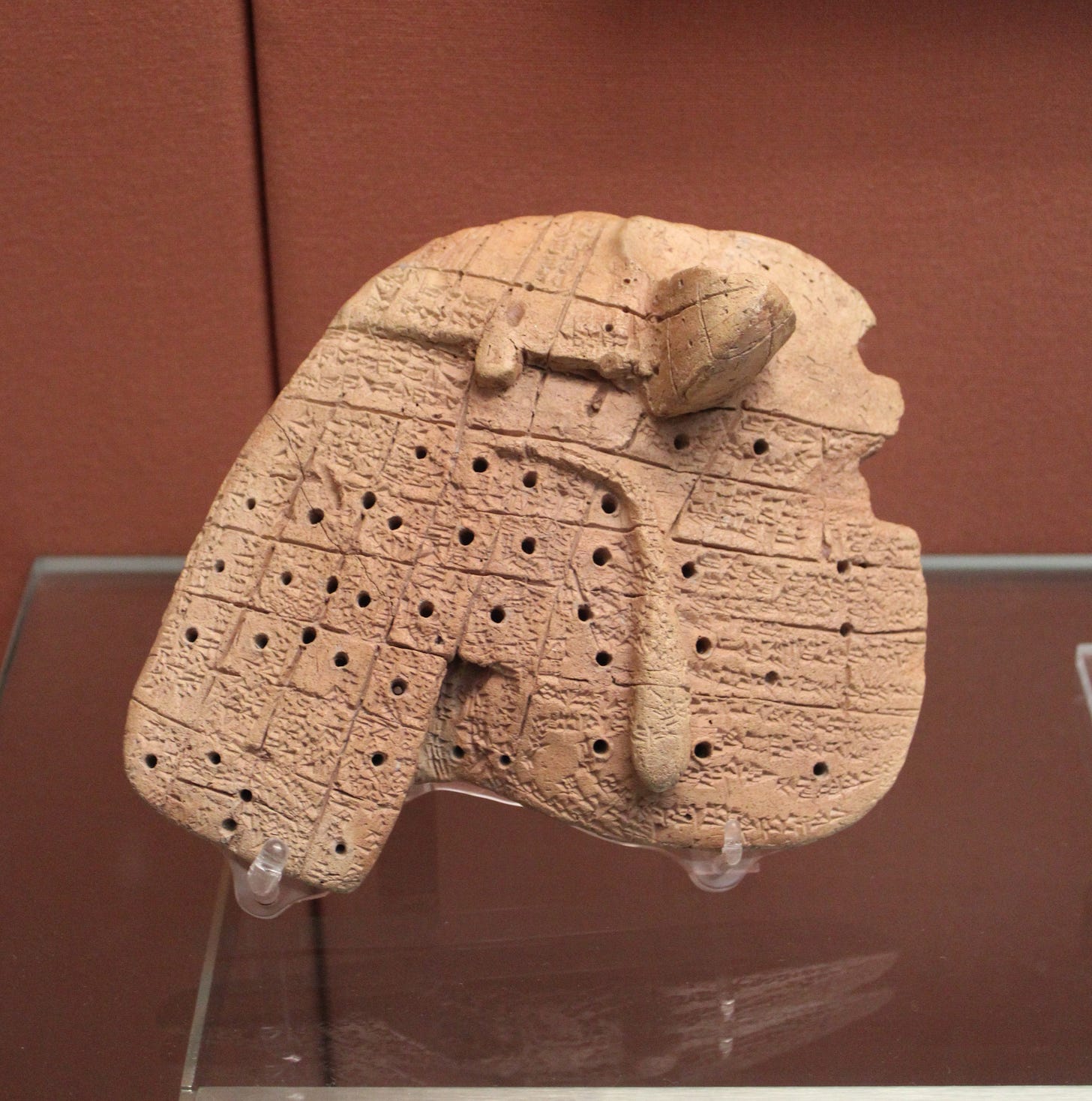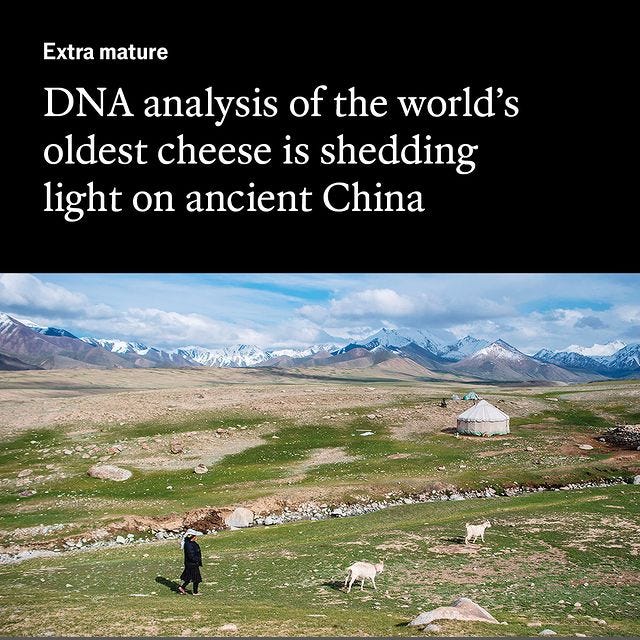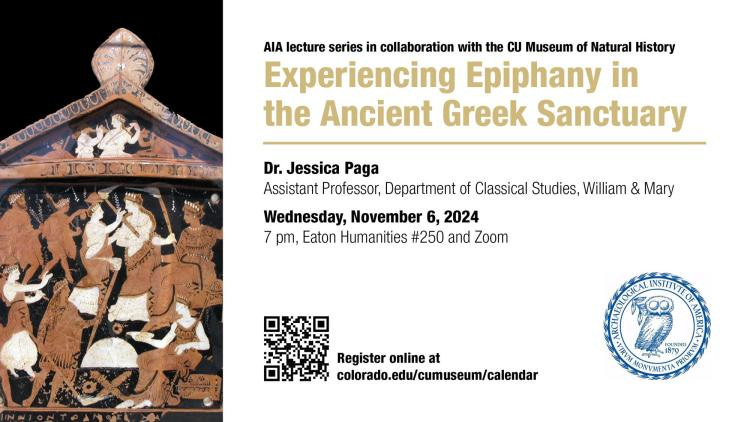Pasts Imperfect (10.10.24)
Egyptian Blue, Bombing Near Baalbek, Medieval Walrus Ivory, and Much More 🖌️

This week, ancient pigment specialists Hilary Becker, Alexandra Rodler-Rørbo, Ariadne Kostomitsopoulou Marketou, Anthony J. Baragona, and Giovanni Verri discuss a recent conference on Egyptian blue and new findings surrounding the famous hue. Then, archaeologists in China discover some ancient funerary cheese, bombing near the Phoenician and Greco-Roman site of Baalbek, retracing the medieval walrus ivory trade, violence and health regimes in imperial Rome, repatriated Yemeni artifacts, new ancient world journals, a polychromy conference, and much moo-re.
Rhapsodies in (Egyptian) Blue by Hilary Becker, Alexandra Rodler-Rørbo, Ariadne Kostomitsopoulou Marketou, Anthony J. Baragona, and Giovanni Verri
The recent discovery of the astonishingly blue room during the ongoing excavations at the Insula 10 of Regio IX in Pompeii is a still frame in the long history of the color blue in Mediterranean antiquity. “Egyptian” blue was the predominant blue colorant in countless works of ancient Mediterranean art. Due to the fact that naturally occurring blue compounds with tinting properties come few and far between, only a handful of blue minerals and even fewer organic colorants can effectively be used for painting.

The first known artificial blue pigment is attested in Egypt ca. 3200 BCE. Around this time, artisans discovered that by firing the relatively common ingredients of quartz sand, lime, copper and an alkali flux together, they could produce a versatile blue material with extraordinary tinting properties that could be used as a pigment. It complemented, and to some extent replaced, precious stones, such as lapis lazuli and turquoise. Shortly thereafter, Egyptian blue would be used by diverse civilizations—Egyptians, Minoans, Mycenaeans, Greeks, Persians, Etruscans, Romans, and others— as the principal blue colorant until the 4th c. C.E., after which time it enjoyed more sporadic use into the medieval and Renaissance periods.
Throughout its impressive life history, Egyptian blue has found applications in wall- and panel-painting and the decoration of architectural elements and ancient sculptures. At the same time, having the properties of a non-clay ceramic, it has been molded into small objects, such as jewelry, amulets, or tiles.
The technological choices, practices, and provenance of Egyptian blue are interesting meeting points for discussing cultural change and trade interactions in human history. Therefore, an interdisciplinary dialogue between archaeologists and natural scientists is desirable to address challenges related to the analysis of archaeological materials.

As Egyptian blue is the product of a highly demanding pyro-technological process, it has kindled the interest of researchers since the 19th century and has ever since been the focus of numerous analytical studies. Increasingly, international researchers have coalesced around their shared passion for this material, manifesting the renewed interest in Egyptian blue in several meetings and symposia.
One such meeting, organized by BLUENET and hosted by the Accademia Nazionale dei Lincei and Parco Archeologico del Colosseo in Rome in October 2022, featured 25 contributions and brought together Egyptian blue enthusiasts from all over the world, to discuss topics such as the means and modes of Egyptian blue detection and usage. This exciting meeting of the BLUENET community also included the production and diffusion of Egyptian blue both from the Mediterranean to eastern Anatolia, and from antiquity to early medieval contexts. Quite fascinating was also the contribution on the non-traditional manufacture of Egyptian blue, which hints at continued Egyptian blue production after the downfall of the Roman empire. Lastly, this meeting even expanded to the future of Egyptian blue and its nanoscale applications. The proceedings of part of this meeting were published as video recordings by Parco Archeologico del Colosseo.

At the end of August 2024, another Egyptian blue gathering took place in Rome - this time during the 30th Annual Meeting of the European Association of Archaeologists (EAA) at La Sapienza University of Rome. The session ‘Egyptian Blue - From Literature to the Artifact to the Lab’ included 16 contributions using experimental archaeology and archaeometry as well as research into ancient texts. The contributions focused on how the first synthetic pigment was made, distributed, and used: from the largest Egyptian blue find in the archaeological record, excavated in the Roman peripheral province of Noricum, to exciting new applications of night vision goggles which provide a highly effective and low-cost means of detecting Egyptian blue. So enthusiastic was the response to this session that the organizers have vowed to build upon their momentum with a future session.
But for those of us who cannot wait that long, at least four of the group from EAA Rome (i.e., Hilary Becker (Binghamton University), Alexandra Rodler-Rørbo (Austrian Archaeological Institute), and Yotam Asscher (University of Haifa) and Giovanni Verri (Art Institute of Chicago), will be presenting later this year at the next Polychromy Roundtable held at the Getty Conservation Institute in Los Angeles in November.

Global Antiquity and Public Humanities
If I dared you to try a piece of 3,500-year-old cheese, would you? No? Archaeologist Fu Qiaomei wouldn’t either. Fu and her team excavated Xiaohe Cemetery in Xinjiang, China, where they found a woman’s coffin with a piece of jewelry laid across her neck. Wait, did they say jewelry? They meant cheese. It was kefir, made with goat’s and cow’s milk. “When asked by NBC if the cheese was edible and if she would try it,” Sky News reports, “Ms. Fu said ‘no way.’”
Over in the London Review of Books, ICS director Katherine Harloe has an essay on “The Last Generation: Classics beyond Balliol,” that reviews Oswyn Murray’s new book, The Muse of History: The Ancient Greeks from the Enlightenment to the Present.
Murray’s sensitivity to the knavery of politicians and the tragedies they unleash sharpens the historical irony of his role in the ascent of the man who did so much to wreck British community with Europe. Boris Johnson read classics at Balliol in the 1980s under the tutelage of Murray and his colleagues. In 2018, around the beginning of Johnson’s premiership, the press reported that Murray had sent him an official renuntiatio amicitiae (renunciation of friendship) in Latin.
And for more from Harloe, her podcast episode on classics and how it “was used to conceptualise same-sex desire in Victorian and Edwardian Britain” is fab.
A new study led by Emily J. Ruiz-Puerta and numerous co-authors in Science Advances explores the trade in walrus ivory in the Middle Ages between ca. 985 and 1450 CE. The study looks at “Norse intermediaries who expanded across the North Atlantic, establishing settlements in Iceland and Greenland.” However, it also examines the Norse contact with Arctic Indigenous peoples by using high-resolution genomic sourcing to follow walrus artifacts "back to specific hunting grounds, demonstrating that Greenland Norse obtained ivory from High Arctic waters, especially the North Water Polynya, and possibly from the interior Canadian Arctic. These results substantially expand the assumed range of Greenland Norse ivory harvesting activities and support intriguing archaeological evidence for substantive interactions with Thule Inuit, plus possible encounters with Tuniit.”

Over in the digital pages of the Society for Ancient Medicine’s Rootcutter, Colin Webster looks at “Violence and Health in Imperial Rome.” In the article, Webster “examines the iconography and architecture of the Baths of Caracalla, as well as the texts of Galen, to outline how men’s fitness in the Roman Empire could be constructed as the ability to cause harm. He reflects on longstanding interconnections between health, fitness and the capacity for violence.” Well, John Wick Chapter 2’s use of the Baths of Caracalla as a filming location is now making a lot more sense.

Over at Hyperallergic, Maya Pontone reports on the Israeli strikes near the ancient Greco-Roman and Phoenician ruins at Baalbek on Sunday, which hit about 500 meters from the site. Pontone also reported on the 14 repatriated Yemeni artifacts which have been lent to the Met indefinitely for research and safekeeping. At around 2,000 years of age, the objects are of the pre-Islamic funerary variety, and will be living at the Met until the Yemeni government decides it’s safe for them to return home.
The objects are thought to originate from the Bayhan District in Yemen’s Shabwah governorate, situated in the southeastern part of the country known for its pre-Islamic heritage. The area encompasses the ancient city of Timna, once the capital of the Qataban Kingdom, which thrived as a commercial and religious hub from the early 7th century until the 1st century BCE.
Ah, to be an anthropologist studying Moche textiles and also having the name of Dr. Jeffrey Quilter. At Harvard’s Peabody Museum, researchers have determined from radiocarbon dating that textiles from the southern highlands of Peru give us a clue to when the Moche civilization “ended.” Because the textiles date from 1,000 years ago, Quilter argues that “a sense of Moche identity may have persisted longer than previously thought.”

And there’s more from Peru: teams led by archaeologists Jessica Ortiz and José Ochatoma may have found proof of a 1,300-year-old, woman-led Moche community at the Pañamarca archeological site on Peru's northwest coast. An excavated throne room revealed a series of intricate murals depicting a female ruler receiving visitors.
Nothing like doing a basement renovation and uncovering medieval-era skeletons and sarcophagi. Talk about spooky season! Vishwam Sankaran at The Independent reports on some French guy who was digging around his suburban Paris cellar last year and found 52 square meters of Late Antique burials. I, personally, would move.
We at PI love when the past can help heal the present. Diné farmers are using technologies from their material history to protect their watersheds in the Black Mesa region of the Navajo reservation. Lela Nargi reports at Yale 360 that farmers like Robert Nutlouis are incorporating “woven brush dams, gabions (wirework cages filled with rocks), earthen berms, concrete spillways and trenches, limestone aprons and walls, and stone-lined ‘Zuni bowls,’ which stabilize eroding streambeds.” Each tiny watershed adds up: by reducing runoff and retaining water, farmers can restore their cultural traditions as well as their environment.
At Psyche, cognitive neuroscientist, Juha Lahnakoski, and Assyriologist, Ellie Bennett discuss their work using computational techniques to explore the bodily experience of emotion in Neo-Assyrian texts and suggest that “To ancient Assyrians, the liver [𒍜𒄯] was the seat of happiness.”

In book news, big congrats to Jordan Rosenblum on the publication of his new book, Forbidden: A 3,000-Year History of Jews and the Pig (NYU Press). 🐷
Jews do not eat pig. This (not always true) observation has been made by both Jews and non-Jews for more than three thousand years and is rooted in biblical law. Though the Torah prohibits eating pig meat, it is not singled out more than other food prohibitions. Horses, rabbits, squirrels, and even vultures, while also not kosher, do not inspire the same level of revulsion for Jews as the pig.
Finally, Business Insider had a great mini-doc on the last of the Benin bronze casters. There are only about 40 of these fantastic casters left in Nigeria.
New Antiquity Journal Issues (by @YaleClassicsLib / yaleclassicslib.bsky.social)
Byzantinische Zeitschrift Vol. 117, No. 3 (2024)
Medieval Ecocriticisms Vol. 4 (2024) #openaccess Medieval Trans Natures
Frühmittelalterliche Studien Vol. 58 (2024) #openaccess
Polygraphia Vol. 6 (2024) #openaccess
Classical Philology Vol. 119, No. 4 (2024) NB Maria Marcinkowska-Rosół & Sven Sellmer “How the Mind Is Affected in Homer and The Sanskrit Epics. Part I: Negative Mental Changes”
Latomus Vol. 83, No. 2 (2024)
Speculum Vol. 99, No. 4 (2024) Essay Cluster: “The Textual Cult of Richard Rolle: Writing Contemplation in Later Medieval England”
Journal of Near Eastern Studies Vol. 83, No. 2 (2024)
Antike und Abendland Vol. 70, No. 1 (2024)
Eventum Vol. 2 (2024) #openaccess Ritual and Gender in Medieval Cultures
Cambridge Archaeological Journal Vol. 34, No. 3 (2024) NB James Ross & Leigh Bettenay “Gold and Silver: Relative Values in the Ancient Past”
Arabian Archaeology and Epigraphy Vol. 35, No. 1 (2024)
Neotestamentica Vol. 57, No. 2 (2023)
Anzeiger für die Altertumswissenschaft Vol. 78, No. 2 (2024) #openaccess
Journal for the Study of the New Testament Vol. 47, No. 1 (2024) Decolonizing New Testament Studies
Anatolia Antiqua Vol. 30 (2022), Vol. 31 (2023) #openaccess
Babesch Vol. 99 (2024)
Journal of the History of Philosophy Vol. 62, No. 4 (2024) NB Patricia Marechal “Porphyry on the Value of Nonhuman Animals”
Theoretical Roman Archaeology Journal Vol. 7 (2024) #openaccess NB Jordon Alex Houston “Exotics for Entertainment: A Reconstruction of the Roman Exotic Beast Trade (First to Third Centuries AD)”
Revue des Études Byzantines Vol. 82 (2024)
European Journal of Archaeology Vol. 27, No. 3 (2024)
Journal of Ancient Judaism Vol. 15, No. 3 (2024) NB David Michael Grossberg ““God Is One” or “the One Is God” in Hellenistic Jewish and Greco-Roman Theology”
Indo-Iranian Journal Vol. 67, No. 3 (2024) NB Francesco Barchi & Benedikt Peschl “‘God of Gods’: An Iranian Buddhist Epithet and Its Traces in Early Chinese Buddhist Translations”
Journal of Roman Archaeology Vol. 37, No. 1 (2024)
NTT Journal for Theology and the Study of Religion Vol.78, No. 3 (2024) A Special Issue about Christine Hayes, ed., The Literature of the Sages: A Re-visioning
Espacio Tiempo y Forma. Serie II, Historia Antigua Vol. 37 (2024) #openaccess
Exhibitions, Events, and Workshops
NYU’s Institute for the Study of the Ancient World continues it series of online professional development workshops for K -12 teachers: Expanding the Ancient World. On October 15th at 5:30pm, Erik Hermans (Villanova), will lead a session on “Global Connections in the Late Antique and Early Medieval World.”
The next AIA Archaeology Hour speaker is Solange Ashby. She will present Ancient African Queens on Wednesday, October 16, at 8pm ET/5pm PT. Register HERE.
The third series of lectures marking the 75th anniversary of the FIEC (Fédération internationale des associations d'études classiques/ International Federation of Associations of Classical Studies) commences online on October 17th at 7pm CEST. Prof. Delfim F. Leâo (University of Coimbra) will speak on “Chilon and the Seven Wise Men: Milestones in the Establishment of a Literary Tradition” Subsequent speakers include Véronique Dasen on “Locus Ludi. The Cultural Fabric of Play and Games in Classical Antiquity” (Oct. 28th) and Marietta Horster on “Roman Cities - a world of (inscribed) texts” (Nov. 17th). Recordings of the previous lecture series are also available on the FIEC site.
At the AIA in Boulder on October 16, 2024, drink up “Caesar’s Cervisia” @ 7PM with Travis Rupp. Then, on November 6, 2024, Jessica Paga will give an AIA lecture for UC-Boulder on “Experiencing Epiphany in the Ancient Greek Sanctuary,” @ 7 pm. Both lectures are on Zoom and in-person.
The 12th International Roundtable on polychromy in ancient sculpture and architecture will be at the J. Paul Getty Museum from November 18-21, 2024. You can register here, but it is in-person only.















